Home automation system based on affordable electronic components - is it real?
Perhaps one of the most significant factors that prevent the home automation system market from achieving impressive growth rates is the cost of the solutions. Moreover, this is observed even if we consider DIY products, and not professional options based on KNX and other technologies that additionally require projects, installers, their wiring, maintenance contracts and other costs.
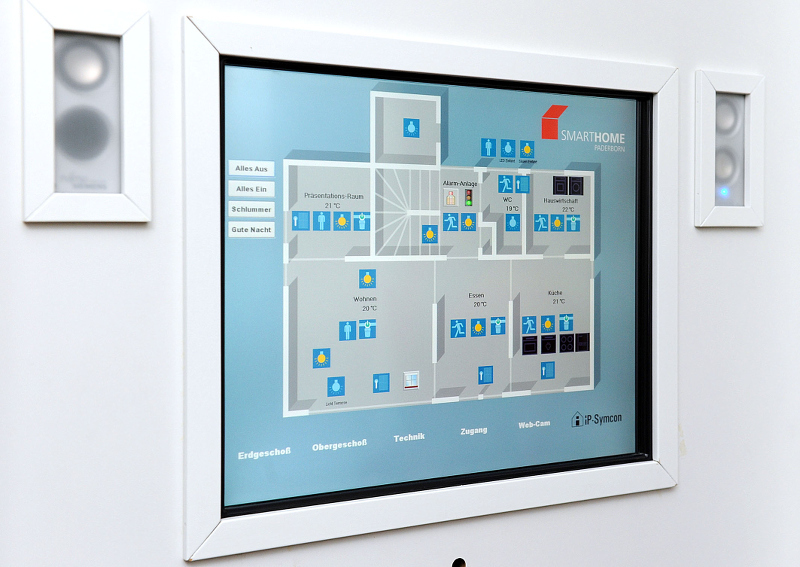
It is entirely possible that this is due to the fact that the manufacturers of these products according to numerous analytical reports see a high interest in this segment and at the growth stage they are trying to secure financial support for investment in development, and also want to “skim the cream” from those consumers who consider them as an alternative to traditional, usually more expensive, solutions.
At the same time, on the market we can observe the emergence of new standards and protocols for automation systems, as well as attempts to adapt existing ones (for example, DECT and Bluetooth) to this task. More and more central nodes - controllers declare in their characteristics multi-platform and multi-protocol. Unfortunately, it is practically impossible to provide in practice a real and convenient operation “out of the box” with all the equipment on the market. So, from a certain point of view, the development of the situation does not inspire optimism - the prices of certified and licensed equipment remain high, and the distribution of “nameless” products is constrained by their dubious consumer characteristics and compatibility. The familiar “but you can buy everything in the Middle Kingdom for three rubles” here is no longer working so effectively.
However, users who want and can do something with their own hands can still find application for their skills. The main thing, in this case, is to enjoy the process, not forgetting to be aware that “good, fast and cheap” at the same time will not work, but you can do anything. For example, let’s pay attention to two points. The first remark concerns high-quality accurate sensors (without strapping) - often they cost decent money even “at their place”, not to mention the absolutely insane prices in some domestic stores. The second question that needs to be answered is how complete the system should be. One or two actuators or sensors may not be visible to the family budget, but providing full control over a three-room apartment will cost a pretty penny.
It is equally important to understand what the purpose of the whole undertaking is, except how to occupy the head and hands. Often there is an opinion that a “smart home” should work so that it will not be noticeable. In reality, it is not so simple to provide advertised functions for saving energy resources or intellectual ensuring a comfortable environment. The definition of algorithms for the interaction of system elements is a very interesting task that deserves a separate publication, so we will not touch on this topic here.
To begin with, it’s worth trying to evaluate and calculate what options are available in terms of other elements of the system. Since we are talking about DIY and lowering costs, looking in the direction of the same Z-Wave is only in exceptional cases. Yes, the sensors and actuators from the same Fibaro impress with their capabilities and compact size, but their cost is quite high. So in this case, it is better to focus on the more familiar communication options, such as Ethernet and Wi-Fi. As an alternative and for simple data exchanges, you can use RS-485, a radio channel in the range of 433 MHz and 1-Wire. By the way, if at the repair stage you brought all the light and other loads with individual cables to the switchboard, this will significantly reduce the cost of actuating devices for controlling them.
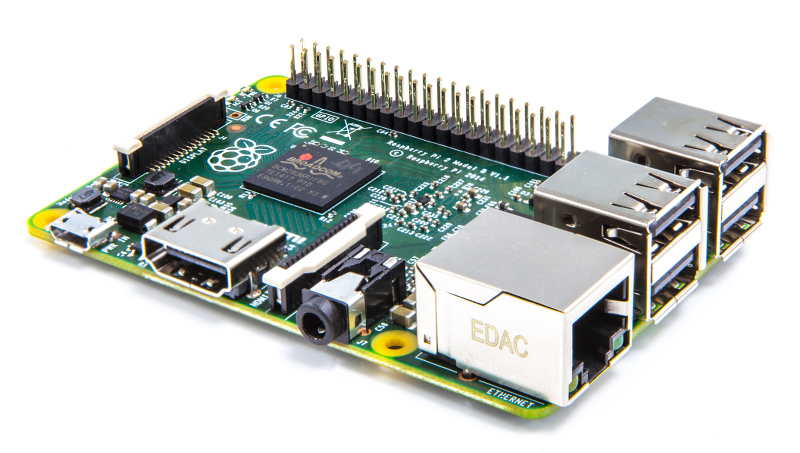
In such circumstances, the easiest to learn choice for the controller will be a microcomputer based on the x86 platform with the Linux or even Windows operating system. If you are used to working with a text console and are not afraid of using a non-x86 architecture, then you can stop at the popular Raspberry Pi. Another option is to add this feature to your home router or network drive, which work continuously. By the way, the balance between “do it yourself” and “take it ready” is very delicate and this is most pronounced in programming. By and large, it’s quite possible to write your own controller program from scratch even in assembler, but whether it will be interesting is a big question. Moreover, there are many projects, including open source, for solving this problem, for example openHAB, Home Assistant, and MajorDoMo . Moreover, the openness of platforms virtually eliminates restrictions on the implementation of the required work algorithms.
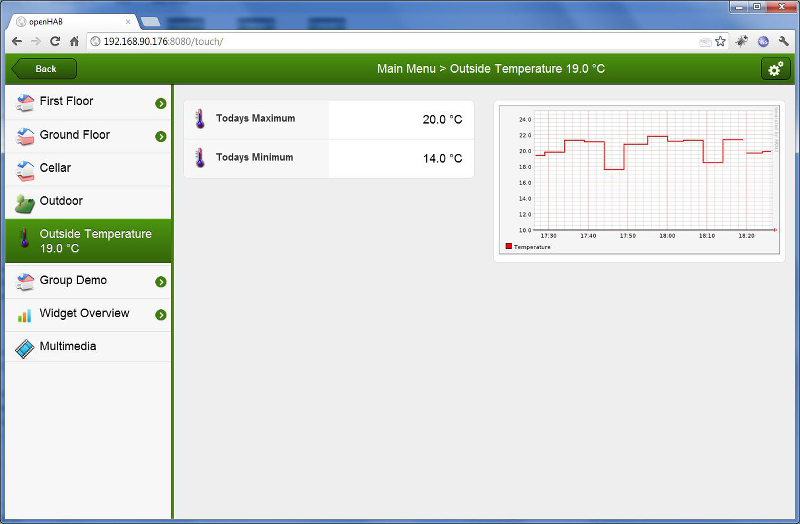
It is also worth mentioning the need to address the issues of reliable connection of the device with the Internet, remote access, security, duplicate notification sending systems. The most common technology options here will be working through cellular networks, using SMS directly or through external services and VPNs.
For sensors and actuators, there is a similar dilemma - to take ready-made or assemble them yourself. True, other factors are additionally involved here, including cost, size, technical specifications, design and others. But the most significant will be the user's level of preparation for working with electronics. If necessary, hundreds of ready-made examples and projects can be found on the network, so the only question is implementation requirements and experience in solving such problems.

As examples of platforms, it is worth recalling the numerous Arduino and their clones, as well as the NodeMCU project and other solutions on the ESP8266 module. The latter are interesting in that they already have a built-in Wi-Fi controller. If you need to make something more compact or more affordable, you can use just the controller chips from Atmel, Microchip and STMicroelectronics. As for the sensors themselves, here the choice is very wide - from the simplest analog options to modern multifunction sensors with digital interfaces. To control the load, mechanical or solid state relays are traditionally used, as well as special circuits if dimming is needed. Note that here you can implement unique solutions that are not available or very expensive in the finished version. For example, a treadmill when illuminating the steps of a staircase.
Of the most noticeable disadvantages of self-made devices compared to ready-made ones, if you look at the technical specifications, you can often name larger sizes, difficulties in implementing long-term battery life (including monitoring their condition), as well as the need to create firmware and develop software interfaces.
Separately, we note the issue of the reliability of the system, directly related to the comfort of working with it and the implementation of some critical functions, including controlling the supply of electricity and water. Manufacturers of many commercial solutions note the use of “special” electronic components in their products, but practice shows that with proper implementation and with “ordinary” models, problems rarely arise. It is more difficult to assess the quality of the software used, and besides how to focus on information from users, there is usually nothing to offer here.
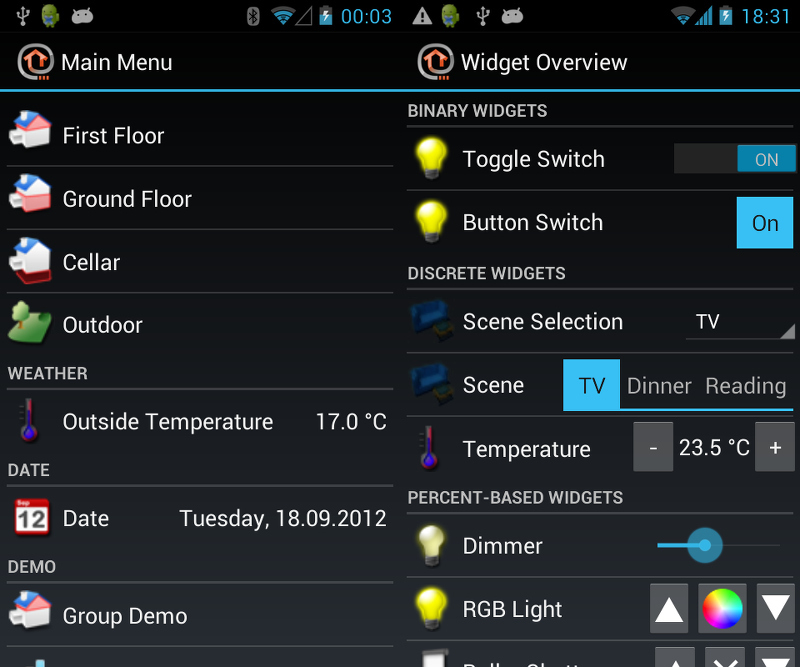
After all the elements for the first project are assembled, the communication channels are configured, the basic interaction algorithms are programmed, a question may arise in the visual representation of the monitoring and control system. The most commonly used option here is perhaps the traditional Web interface. Some of the controller projects mentioned above have additional proprietary utilities for mobile devices based on Android and iOS. Usually they provide basic management capabilities, may not support all the variety of your devices, and also rarely allow you to flexibly change the appearance of the panels.
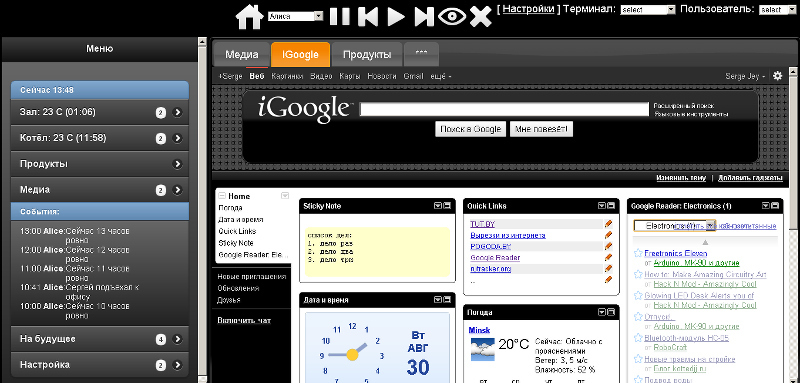
Of course, it is difficult to call the requirement of a beautiful and user-friendly design mandatory for the considered solutions focused on DIY and affordable segment, but still sometimes you want to give your development an effective and finished look. Moreover, the “kitchen" itself in this case is usually hidden from view. If you are not ready to write your own application to solve this problem, then you can use third-party products, one of the leading among which is iRidium Mobile today. Note that this is a commercial product and its cost for the end user with the driver required in this case is 10,000 rubles, which is expensive for this type of installation, but will give it a professional and finished look. However, there is an opportunity to get acquainted with all its features for free thanks to licenses with a limited validity period,
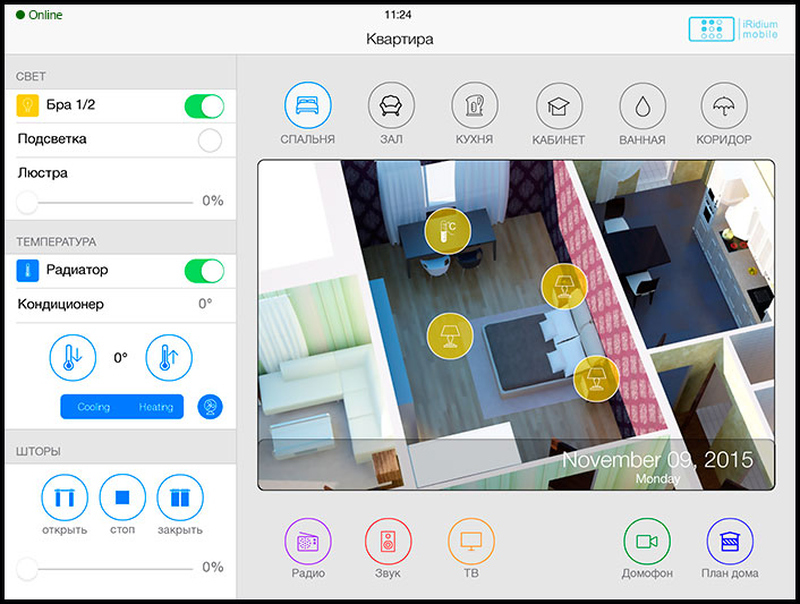
For our task, the program is interesting in that it has clients for Android, iOS, OS X and Windows, allows you to create control panel designs as flexibly as possible (including based on ready-made examples), requires minimal training, allows you to use JS to program built-in algorithms, It has a ready-made AV & Custom Systems driver for interacting with devices over the TCP / IP protocol, as well as a large set of additional modules for various equipment, including working with multimedia.
Summarizing this material, we repeat once again the main idea - you can do everything. The main question will be in choosing the right balance for you between “order a ready-made solution” and “do it yourself”. At the same time, it can be noted in it several separate directions corresponding to elements of the system - the controller, software, interaction algorithms, communication protocols and environment, sensors and actuators, control interfaces. Of course, one person should not exclude the possibility of having all the necessary knowledge and experience for the implementation of a project by one person. However, the situation is more real when you can choose the topics that are most interesting for you for independent implementation and take ready-made solutions for others. As for the cost, it is adequate to estimate the costs of own time, including some “compensation” for an interesting lesson, is impossible. If we talk about equipment, then the assessment only "for hardware" is rarely accurate. It is worthwhile to think over the budget in advance and focus on the gradual growth of the system.

It is entirely possible that this is due to the fact that the manufacturers of these products according to numerous analytical reports see a high interest in this segment and at the growth stage they are trying to secure financial support for investment in development, and also want to “skim the cream” from those consumers who consider them as an alternative to traditional, usually more expensive, solutions.
At the same time, on the market we can observe the emergence of new standards and protocols for automation systems, as well as attempts to adapt existing ones (for example, DECT and Bluetooth) to this task. More and more central nodes - controllers declare in their characteristics multi-platform and multi-protocol. Unfortunately, it is practically impossible to provide in practice a real and convenient operation “out of the box” with all the equipment on the market. So, from a certain point of view, the development of the situation does not inspire optimism - the prices of certified and licensed equipment remain high, and the distribution of “nameless” products is constrained by their dubious consumer characteristics and compatibility. The familiar “but you can buy everything in the Middle Kingdom for three rubles” here is no longer working so effectively.
However, users who want and can do something with their own hands can still find application for their skills. The main thing, in this case, is to enjoy the process, not forgetting to be aware that “good, fast and cheap” at the same time will not work, but you can do anything. For example, let’s pay attention to two points. The first remark concerns high-quality accurate sensors (without strapping) - often they cost decent money even “at their place”, not to mention the absolutely insane prices in some domestic stores. The second question that needs to be answered is how complete the system should be. One or two actuators or sensors may not be visible to the family budget, but providing full control over a three-room apartment will cost a pretty penny.
It is equally important to understand what the purpose of the whole undertaking is, except how to occupy the head and hands. Often there is an opinion that a “smart home” should work so that it will not be noticeable. In reality, it is not so simple to provide advertised functions for saving energy resources or intellectual ensuring a comfortable environment. The definition of algorithms for the interaction of system elements is a very interesting task that deserves a separate publication, so we will not touch on this topic here.
To begin with, it’s worth trying to evaluate and calculate what options are available in terms of other elements of the system. Since we are talking about DIY and lowering costs, looking in the direction of the same Z-Wave is only in exceptional cases. Yes, the sensors and actuators from the same Fibaro impress with their capabilities and compact size, but their cost is quite high. So in this case, it is better to focus on the more familiar communication options, such as Ethernet and Wi-Fi. As an alternative and for simple data exchanges, you can use RS-485, a radio channel in the range of 433 MHz and 1-Wire. By the way, if at the repair stage you brought all the light and other loads with individual cables to the switchboard, this will significantly reduce the cost of actuating devices for controlling them.

In such circumstances, the easiest to learn choice for the controller will be a microcomputer based on the x86 platform with the Linux or even Windows operating system. If you are used to working with a text console and are not afraid of using a non-x86 architecture, then you can stop at the popular Raspberry Pi. Another option is to add this feature to your home router or network drive, which work continuously. By the way, the balance between “do it yourself” and “take it ready” is very delicate and this is most pronounced in programming. By and large, it’s quite possible to write your own controller program from scratch even in assembler, but whether it will be interesting is a big question. Moreover, there are many projects, including open source, for solving this problem, for example openHAB, Home Assistant, and MajorDoMo . Moreover, the openness of platforms virtually eliminates restrictions on the implementation of the required work algorithms.

It is also worth mentioning the need to address the issues of reliable connection of the device with the Internet, remote access, security, duplicate notification sending systems. The most common technology options here will be working through cellular networks, using SMS directly or through external services and VPNs.
For sensors and actuators, there is a similar dilemma - to take ready-made or assemble them yourself. True, other factors are additionally involved here, including cost, size, technical specifications, design and others. But the most significant will be the user's level of preparation for working with electronics. If necessary, hundreds of ready-made examples and projects can be found on the network, so the only question is implementation requirements and experience in solving such problems.

As examples of platforms, it is worth recalling the numerous Arduino and their clones, as well as the NodeMCU project and other solutions on the ESP8266 module. The latter are interesting in that they already have a built-in Wi-Fi controller. If you need to make something more compact or more affordable, you can use just the controller chips from Atmel, Microchip and STMicroelectronics. As for the sensors themselves, here the choice is very wide - from the simplest analog options to modern multifunction sensors with digital interfaces. To control the load, mechanical or solid state relays are traditionally used, as well as special circuits if dimming is needed. Note that here you can implement unique solutions that are not available or very expensive in the finished version. For example, a treadmill when illuminating the steps of a staircase.
Of the most noticeable disadvantages of self-made devices compared to ready-made ones, if you look at the technical specifications, you can often name larger sizes, difficulties in implementing long-term battery life (including monitoring their condition), as well as the need to create firmware and develop software interfaces.
Separately, we note the issue of the reliability of the system, directly related to the comfort of working with it and the implementation of some critical functions, including controlling the supply of electricity and water. Manufacturers of many commercial solutions note the use of “special” electronic components in their products, but practice shows that with proper implementation and with “ordinary” models, problems rarely arise. It is more difficult to assess the quality of the software used, and besides how to focus on information from users, there is usually nothing to offer here.

After all the elements for the first project are assembled, the communication channels are configured, the basic interaction algorithms are programmed, a question may arise in the visual representation of the monitoring and control system. The most commonly used option here is perhaps the traditional Web interface. Some of the controller projects mentioned above have additional proprietary utilities for mobile devices based on Android and iOS. Usually they provide basic management capabilities, may not support all the variety of your devices, and also rarely allow you to flexibly change the appearance of the panels.

Of course, it is difficult to call the requirement of a beautiful and user-friendly design mandatory for the considered solutions focused on DIY and affordable segment, but still sometimes you want to give your development an effective and finished look. Moreover, the “kitchen" itself in this case is usually hidden from view. If you are not ready to write your own application to solve this problem, then you can use third-party products, one of the leading among which is iRidium Mobile today. Note that this is a commercial product and its cost for the end user with the driver required in this case is 10,000 rubles, which is expensive for this type of installation, but will give it a professional and finished look. However, there is an opportunity to get acquainted with all its features for free thanks to licenses with a limited validity period,

For our task, the program is interesting in that it has clients for Android, iOS, OS X and Windows, allows you to create control panel designs as flexibly as possible (including based on ready-made examples), requires minimal training, allows you to use JS to program built-in algorithms, It has a ready-made AV & Custom Systems driver for interacting with devices over the TCP / IP protocol, as well as a large set of additional modules for various equipment, including working with multimedia.
Summarizing this material, we repeat once again the main idea - you can do everything. The main question will be in choosing the right balance for you between “order a ready-made solution” and “do it yourself”. At the same time, it can be noted in it several separate directions corresponding to elements of the system - the controller, software, interaction algorithms, communication protocols and environment, sensors and actuators, control interfaces. Of course, one person should not exclude the possibility of having all the necessary knowledge and experience for the implementation of a project by one person. However, the situation is more real when you can choose the topics that are most interesting for you for independent implementation and take ready-made solutions for others. As for the cost, it is adequate to estimate the costs of own time, including some “compensation” for an interesting lesson, is impossible. If we talk about equipment, then the assessment only "for hardware" is rarely accurate. It is worthwhile to think over the budget in advance and focus on the gradual growth of the system.
